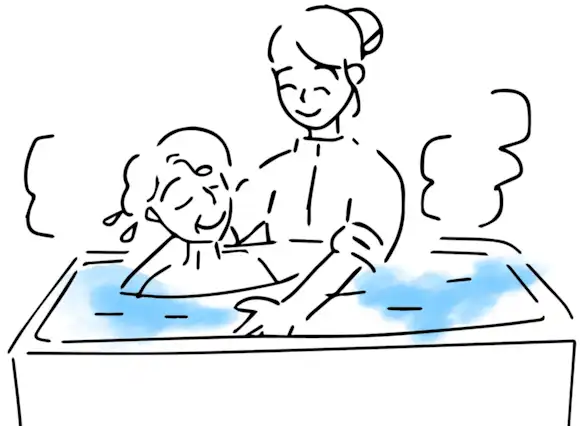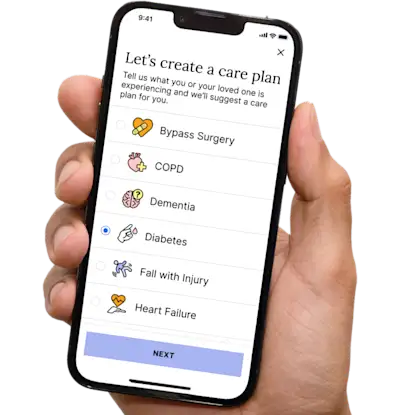Caregiving Challenges, Bathing and Toileting Your Loved One
Bathing and toileting adult loved ones is not the same experience as bathing and toileting children. How to cope with vulnerability and embarrassment.
Get insurance benefits, legal documents, and medical records in one place

Helpful Highlights
Bathing, grooming, and hygiene can be a very different experience for older adults, especially those with confusion or memory loss.
Older adults cannot describe their concerns about bathing and their fears may seem irrational to us, resulting in our frustration.
Patience and kindness, both with yourself and your loved one, are essential to a positive and productive bathing experience.
Toileting is what it is, but we have some helpful hints.
Bathing, grooming, and hygiene - is there a difference?
Yes, there is a difference, though they are commonly referred to as just "bathing." Bathing, grooming, and hygiene are considered activities of daily living (ADLs) and are often grouped together.
Bathing: Wasing the body surfaces, including hands, feet, face, and private areas, and washing hair.
Grooming: Activities such as shaving, beard and mustache maintenance, hair care and styling, and applying make-up. Grooming is also commonly paired with another ADL - dressing.
Hygiene: Eye and ear care, brushing teeth and oral care, applying lotions and powders, and nail care. Note that hygiene always includes regular hand washing!
Bathing and hygiene are just as important in older age as they are in any other time of life. Bathing twice a week is sufficient for most older adults, though bathing should be done more often if needed. Oral care should be performed daily.
The aging process
As we age, the powerful protective barriers that are our skin and mucous membranes weaken dramatically.
Moisture decreases
Excessively dry skin can cause itching (and scratching), eczema, and flaking that can visibly collect on materials and surfaces causing embarrassment, as well as cracking and bleeding that is painful and increases the risk of infection.
Dry eyes can cause redness, itching, swelling, and/or pain, increased risk of eye infections, abrasions to the cornea and corneal ulcers, and reduced vision.
Dry mouth can cause lip and mouth cracking and sores, thrush (yeast infection of the mouth), increased plaque, tooth decay, gum disease, and poor nutrition from chewing or swallowing problems.
Sloughing slows down
Surface pH (acidity) changes
Layers of the skin become thinner
Connective tissue breaks down causing skin to "slide"
Healing time increases
Teeth and gums deteriorate
The importance of bathing and what we take for granted
As we age, washing everywhere - under folds, in crevices, and in hard-to-reach areas - is more difficult. For those who have confusion or memory loss, washing everywhere can be nearly impossible without assistance.
There does not have to be obvious soiling or an open wound for older adults to be at risk for infections and other problems from not bathing.
The bathing experience - knowledge
For older adults, bathing can be quite tasking.
They don't wish to be a burden, so won't ask for help.
They may worry about their safety while bathing, so they avoid it.
Those with confusion or memory loss may fear water (see Helpful Guide on Dementia-Related Fear of Water, Refusal to Bathe)
Shower benches, non-slip mats, and grab bars should be used.
The bathing experience - skills
It is best practice to start at the center of the body (private areas first, then the torso) and work outward, finishing with hands, feet, and finally face. However, when bathing the older adult, it is better to start with the face, hands, and feet and work toward the center (torso then private areas). But why?
Your face remains where your loved one can see it.
Washing hands and feet first promotes security (trust) and relaxation.
It encourages your loved one to help if they wish.
It helps prevent them from getting cold, especially if bathing takes a while because their core and head can be covered.
It's physically and mentally stimulating (we have the most nerve endings in our face, hands, and feet).
Intimacy vs. embarrassment - reframing the approach
Rushing through showering or bathing is commonplace for many of us; however, it can provoke anxiety, fright, and even anger in older adults.
Commit to taking your time.
Prepare the bathroom and bathing space with everything you need ahead of time.
Preserve their dignity and modesty by covering the things you can when you can, and letting them choose how they want to position themselves.
If your loved one prefers the bath - use bubbles to cover things!
Use the time to demonstrate your love for them.
If you approach them with irritation, they will respond to it.
If you approach them with care and affection, they will respond to it.
When necessary, consider replacing showing/bathing with a basin and washcloths* or prepackaged bathcloths. (*Note that washcloths should only be used once and then set aside. Rinsing and reusing washcloths that have already touched the body contaminate the basin water. Therefore, you will need several.)
Lean into intimacy rather than trying to avoid embarrassment.
There's also no need for constant talking. Some people do this to cover awkwardness. It's best to explain what you're about to do, and then be quiet while doing it.
Toileting
Well, let's face it, there's really no way to make toileting an intimate and caring experience, though it is a tremendous act of love. So, we'll just offer some helpful hints:
Let your loved one do as much as they can to remove garments and get seated on the toilet. Likewise, let them do as much as they can to rise off the toilet and replace garments.
Do not remain in the bathroom with them while they're on the toilet unless absolutely necessary. Give them privacy.
Do not make them call for you when they're finished like a child does. Stay by the bathroom and check on them periodically. Over time, you will know when they're finished.
The only toileting smells we tolerate are our own and our children's, so when you enter the bathroom, remember to remain pleasant. Don't wrinkle your face, gasp or grunt, or comment on the odor.
Glove up. (DO NOT flush gloves.)
Use wipes instead of toilet paper. (DO NOT flush wipes, even if they say "flushable"!)
They clean better, don't stick, and you'll probably save yourself repeated wiping.
Flush immediately after they rise (but do not flush while they're still seated, the cool vacuum feeling is uncomfortable).
Both of you wash your hands afterward.
RESOURCES
Alzheimer's Association - Bathing
Caregiver Action Network - Bathing Tips for Older Adults
Cleveland Clinic. (2023, April 17). Taking the plunge: 5 reasons baths are good for you. Health Essentials, Family Medicine. Link
Lam, K., Shi, Y., Boscardin, J., & Covinsky, K.E. (2021). Unmet need for equipment to help with bathing and toileting among older US adults. JAMA Internal Medicine, 181(5), 662-670. DOI
Rader, J., Barrick, A.L., Hoeffer, B., Sloane, P.D., McKenzie, D., Talerico, K.A., & Glover, J.U. (2006). The bathing of older adults with dementia: Easing the unnecessarily unpleasant aspects of assisted bathing. American Journal of Nursing, 106(4), 40-48. Link
Chia-Hui, T., Tsung-Cheng, H., & Ru-Ping, L. (2021). The effect of two bed bath practices in cost and vital signs of critically ill patients. International Journal of Envrionmental Research and Public Health, 18(2), 816. DOI
No content in this app, regardless of date, should ever be used as a substitute for direct medical advice from your doctor or other qualified clinician.
Get more support and guidance on insurance benefits, medical records and legal forms.
Helpful brings together your insurance benefits, legal documents, and medical records in one personalized place — so you always know what you have, and never have to search again.

Technology for Health Tasks. Mental Health for the Tough Stuff.
Helpful connects your medical records, insurance, and caregiving tasks automatically. And when you need more than logistics, a therapist is here to guide you.
In-Network and Covered
For Individuals, Couples and Families
HIPAA Compliant, Data Stays Private


Healthcare Tasks Simplified

From syncing records to spotting drug interactions, Helpful does the heavy lifting, turning complex health info into clear tasks and showing you benefits you can actually use, giving you clarity and control over your care.

In-Network Mental Health

Our licensed therapists are here to support you and your loved ones through stress, burnout, and life’s hardest moments, with an inclusive, compassionate approach that works with most insurance plans.

Create Legal Documents

Plan ahead by creating will, trusts, advance directives and more, that ensure your wishes are honored in the event you can’t speak for yourself -with Helpful guiding you every step of the way.